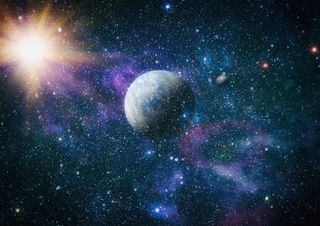Water Deep in Earth's Core May Come from Dust Swirling Around the Sun

Where did the building blocks of Earth's first water come from?
At least in part, from a cloud of gas and dust swirling around the sun, new research suggests.
Water is made up of two hydrogen atoms and one oxygen atom, and rocky asteroids likely carried most of that hydrogen to Earth billions of years ago. However, the new research suggests that young Earth also received hydrogen from the solar nebula.
"Nearly one out of every 100 water molecules on Earth came from the solar nebula," researchers wrote in the new study, which was published online Oct. 9 in the Journal of Geophysical Research: Planets.
In the early solar system, this cloud — the material leftover after the sun's formation — contained large amounts of hydrogen. But before this study, researchers hadn't looked at whether the nebula provided much of Earth's hydrogen, they reported. [Photo Timeline: How the Earth Formed]
To find out where Earth's water came from, scientists examined its chemical fingerprints, looking at ratios of hydrogen isotopes — versions of hydrogen with different numbers of neutrons and, therefore, different atomic mass.
The ratio of normal hydrogen and deuterium — a heavier isotope — in ocean water matches the ratio found in water from asteroids, suggesting that Earth's water had asteroid origins. However, hydrogen extracted from the planet's interior, near the region where the mantle meets the core, tells a different tale. Those samples had less deuterium than hydrogen compared with ocean water, pointing to a source other than asteroids, according to the study.
Sign up for the Live Science daily newsletter now
Get the world’s most fascinating discoveries delivered straight to your inbox.
Earth took shape billions of years ago, when smaller asteroids collided and fused into a larger body. As the newborn, still-molten planet formed, it siphoned dust and gas from the solar nebula, the new model suggests. The nebula's hydrogen sank into baby Earth's molten magma, drawn toward its magnetic core. Meanwhile, hydrogen from asteroids lingered in what eventually became the mantle, the researchers explained.
Asteroid impacts continued to bombard Earth and build up its "body," and as they did, they distributed hydrogen with a higher deuterium ratio in the mantle and in Earth's oceans. While this hydrogen makes up most of the planet's water, the scientists concluded that some water owes its formation to hydrogen from the nebula.
What's more, quantities of water are thought to be hidden inside the planet —"roughly two oceans in the mantle and four to five oceans in the core," much of which likely originated from the solar nebula, the scientists reported.
Their findings also hint that similar processes could shape the formation of water on distant exoplanets, lead study author Jun Wu, an assistant research professor in the School of Molecular Sciences and School of Earth and Space Exploration at Arizona State University, said in a statement.
"This model suggests that the inevitable formation of water would likely occur on any sufficiently large exoplanets in extrasolar systems," Wu said. "I think this is very exciting," he said.
Originally publishedon Live Science.

Mindy Weisberger is an editor at Scholastic and a former Live Science channel editor and senior writer. She has reported on general science, covering climate change, paleontology, biology, and space. Mindy studied film at Columbia University; prior to Live Science she produced, wrote and directed media for the American Museum of Natural History in New York City. Her videos about dinosaurs, astrophysics, biodiversity and evolution appear in museums and science centers worldwide, earning awards such as the CINE Golden Eagle and the Communicator Award of Excellence. Her writing has also appeared in Scientific American, The Washington Post and How It Works Magazine.
Most Popular


